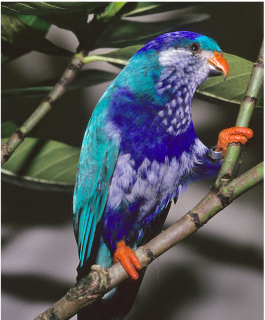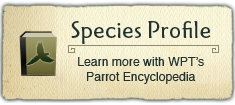Project Regions:
Ultramarine Lorikeet |
|
|
Collaborators/Funders
People of French Polynesia and especially of the Marquesas Islands, Birds Australia Parrot Association, Société d’Ornithologie de Polynésie, Service du Développement Rural and the University of Adelaide.
Island parrot on the edge of extinction
The Ultramarine Lorikeet is at risk from introduced predators, habitat loss and degradation, and disease.
Project and progress: The Ultramarine Lorikeet benefited from a WPT Small Grant, which supported:
- Studying the ecology of the birds
- Maintaining the population's stability
- Determining the feasibility of a rat eradication programme
- Educating local communities
Outcomes: In 2003 WPT, through its Small Grants Programme, supported a research and conservation program designed to increase the understanding of the species' ecology and conservation requirements, determine the status and distribution of the species’ populations on each island within its range, stabilise their decline, confirm the rat-free status of Ua Huka, evaluate the feasibility of a rat eradication programme on Fatu Hiva, and raise awareness about the species’ plight to local people.
World population: 1000 - 2500
Where found: Restricted to Marquesas Islands of Nuku Hiva, Ua Pu and Ua Huka; fossil remains show that this species formerly ranged more widely.
History: The Ultramarine Lorikeet (Vini ultramarina) is found on the Marquesas Islands in French Polynesia. On Ua Pou and Nuku Hiva, where it was still found in 1975 by the 1990s had disappeared. (Holyoak and Thibault 1984, Seitre and Seitre 1991, Te Manu 1998 24:1) Recently a few birds have been spotted on these two islands, but are thought to be transplants from Ua Huka (J.C. Thibault in litt. 2000). Reintroductions to Ua Huka and Fatu Hiva have been fairly successful, with populations remaining stable or increasing slightly (Holyoak and Thibault 1984, Thibault 1988, Kuehler et al. 1997, and Ziembicki and Raust 2004). In 2010 Doukas reported 2094 individuals in total. In Fatu Hiva rats became established and by 2007 the species was considered extinct there (Ziembicki and Raust 2004, P. Raust in litt. 2007, J.Y. Meyer and J.C. Thibault unpublished data).
Threats:
- Restricted range endangers remaining birds to predation by introduced animals
- Loss of habitat due to very high levels of grazing and fire
- Clearing of trees for agriculture and wood carvings for tourism
Ecology: The Ultramarine Lorikeet is found above 700m (2296 ft) elevation, in montane forest. Birds have also been seen in banana, coconut and mango plantations in coastal areas. They eat fruit, insects, pollen and nectar and feed in flowering trees. They are noisy and conspicuous in spite of low numbers, and may allow close approach. Birds stay at or near the top of the forest canopy.


































